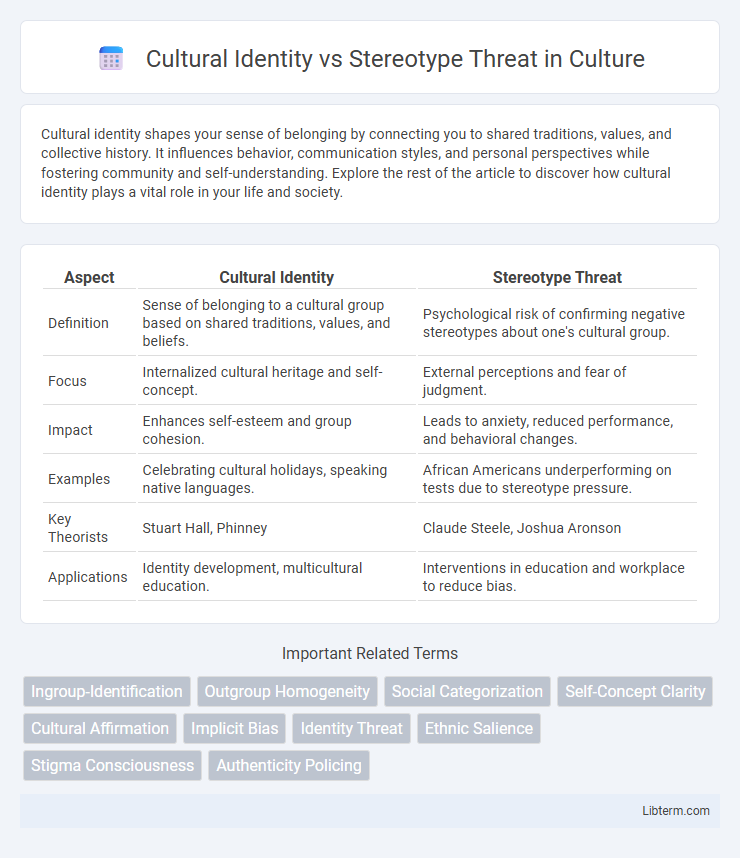Cultural identity shapes your sense of belonging by connecting you to shared traditions, values, and collective history. It influences behavior, communication styles, and personal perspectives while fostering community and self-understanding. Explore the rest of the article to discover how cultural identity plays a vital role in your life and society.
Table of Comparison
| Aspect | Cultural Identity | Stereotype Threat |
|---|---|---|
| Definition | Sense of belonging to a cultural group based on shared traditions, values, and beliefs. | Psychological risk of confirming negative stereotypes about one's cultural group. |
| Focus | Internalized cultural heritage and self-concept. | External perceptions and fear of judgment. |
| Impact | Enhances self-esteem and group cohesion. | Leads to anxiety, reduced performance, and behavioral changes. |
| Examples | Celebrating cultural holidays, speaking native languages. | African Americans underperforming on tests due to stereotype pressure. |
| Key Theorists | Stuart Hall, Phinney | Claude Steele, Joshua Aronson |
| Applications | Identity development, multicultural education. | Interventions in education and workplace to reduce bias. |
Understanding Cultural Identity: Definition and Importance
Cultural identity refers to the sense of belonging to a particular cultural group, shaped by shared customs, language, values, and traditions that influence an individual's self-concept and worldview. Understanding cultural identity is crucial because it provides a foundation for personal resilience, social cohesion, and psychological well-being, enabling individuals to navigate diverse social environments confidently. Recognizing the significance of cultural identity helps combat stereotype threat, which occurs when negative stereotypes about one's group undermine performance and self-esteem.
What is Stereotype Threat?
Stereotype threat refers to the psychological phenomenon where individuals feel at risk of confirming negative stereotypes about their social group, which can impair their performance and self-confidence. This threat often arises in academic, professional, or social contexts where certain stereotypes are prevalent, leading to anxiety and reduced ability to perform tasks effectively. Understanding stereotype threat is crucial for addressing disparities in educational and workplace outcomes related to cultural identity.
The Interplay Between Cultural Identity and Stereotype Threat
Cultural identity profoundly influences an individual's vulnerability to stereotype threat, which occurs when negative societal assumptions undermine performance and self-esteem. Strong, positive cultural identification can serve as a protective factor, bolstering resilience against stereotype-induced anxiety and enhancing cognitive functioning. Conversely, weak or conflicted cultural identity may exacerbate stereotype threat, intensifying stress and impairing achievement in social and academic contexts.
How Stereotype Threat Impacts Personal and Academic Performance
Stereotype threat negatively affects personal and academic performance by inducing anxiety and reducing working memory capacity, which impairs cognitive functioning during critical tasks. Individuals aware of negative stereotypes about their social group often experience heightened stress, leading to underperformance on exams and in academic settings. This psychological burden undermines confidence, motivation, and ultimately limits educational achievement and personal growth.
Cultural Identity as a Buffer Against Stereotypes
Cultural identity strengthens self-perception and resilience, acting as a buffer against stereotype threat by fostering a strong sense of belonging and self-worth. Individuals with a positive cultural identity can better resist the negative effects of stereotypes, reducing anxiety and enhancing performance in stereotype-relevant situations. Research shows that affirming cultural identity mitigates the cognitive and emotional impact of stereotype threat, promoting psychological well-being and academic or professional success.
Societal Influences on Cultural Identity Formation
Societal influences shape cultural identity through norms, media representation, and educational systems that reinforce specific group narratives. Stereotype threat arises when individuals fear confirming negative stereotypes about their cultural group, impacting performance and self-perception. Exposure to diverse role models and inclusive environments mitigates stereotype threat and fosters a positive cultural identity.
Recognizing and Challenging Stereotypes in Daily Life
Recognizing and challenging stereotypes in daily life involves actively questioning generalized beliefs about cultural identity and acknowledging the diversity within groups. Strategies such as education, self-reflection, and open dialogue help dismantle stereotype threat by promoting an inclusive environment where individuals feel valued for their unique experiences. Empowering people to confront biases encourages authentic self-expression and reduces the psychological impact of stereotype-based expectations.
Strategies to Overcome Stereotype Threat
Implementing strategies such as affirming cultural identity through positive self-affirmations and engaging in environments that celebrate diversity can reduce the impact of stereotype threat. Exposure to role models sharing similar cultural backgrounds and success stories strengthens resilience against negative stereotypes. Cognitive reframing techniques help individuals reinterpret anxiety and pressure as challenges rather than threats, promoting better performance and psychological well-being.
The Role of Education in Strengthening Cultural Identity
Education plays a crucial role in strengthening cultural identity by incorporating diverse curricula that reflect students' heritage, promoting self-awareness and pride in their backgrounds. Culturally responsive teaching methods help counteract stereotype threat by fostering an inclusive environment where all cultural identities are validated and respected. Empowering students through education cultivates resilience against negative stereotypes, enhancing academic engagement and psychological well-being.
Building Inclusive Environments to Reduce Stereotype Threat
Creating culturally inclusive environments involves recognizing diverse identities and actively challenging stereotypes through policies and practices that promote representation and equity. Implementing inclusive curricula, fostering open dialogues, and providing support systems can significantly reduce stereotype threat by validating individuals' cultural identities. These strategies enhance a sense of belonging and improve performance and well-being in educational and professional settings.
Cultural Identity Infographic

 libterm.com
libterm.com